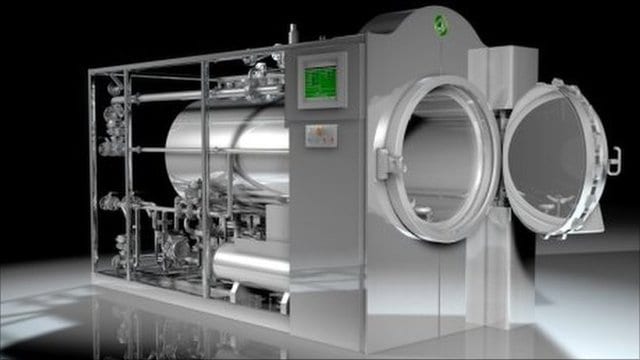While it might be a stretch as a tool, this was too good to pass up when we heard about the first commercial alkaline hydrolysis machine (read body liquefaction tool) installed in a funeral home in Florida. With this machine, which really is just a special process that involves some pressure and heated alkaline water, we can literally turn a human body into liquid. This seems like a reasonable thing to do since it is estimated that a human body is about 60% water for adult males and 70% for adult females. Seeing how a significant amount of a human body is water, wouldn’t it be easier to turn it back to water rather than trying to burn it up with cremation? Some are even touting this as a “green” alternative to cremation.
Body Liquefaction Tool Features
The initial body liquefaction tool has been installed at a funeral home in St. Petersburg, Florida and it will be used for the first time in the coming weeks. The installation was only made possible after state legislature in Florida approved the use of the new technology. Florida is one of seven US states in which the process has now been legalized. The manufacturer, Resomation Ltd, which is based in Glasgow, Scotland, claims that their process produces a third less greenhouse gas than cremation, uses one-seventh the energy, and allows for the complete separation of dental amalgam (teeth fillings) for safe disposal. In the United Kingdom, mercury from amalgam vaporized in crematoria is blamed for up to 16% of the airborne mercury emissions, and many crematoria are currently installing mercury filtration systems to better meet reduced emission targets.
The body liquefaction tool works by submerging the body in a solution of water and potassium hydroxide which is pressurized to 10 atmospheres (147 psi) and heated to 256 degrees Fahrenheit for between two-and-a-half and three hours. The body tissue is then dissolved and the liquid poured into the municipal water system. Tests have proven the effluent is sterile and contains no DNA, and poses no environmental risk. Since the bones do not breakdown in this process, they are removed from the unit and processed in a cremulator, which is the same machine that is used to crush bone fragments following cremation into ash. Metals including mercury, artificial joints, and implants are safely recovered at this point as well.
Choices are expanding… now you can plant your loved one in a traditional cemetery, cremate them, or, thanks to liquefaction coming to a funeral home near you, you can flush them down the drain.


